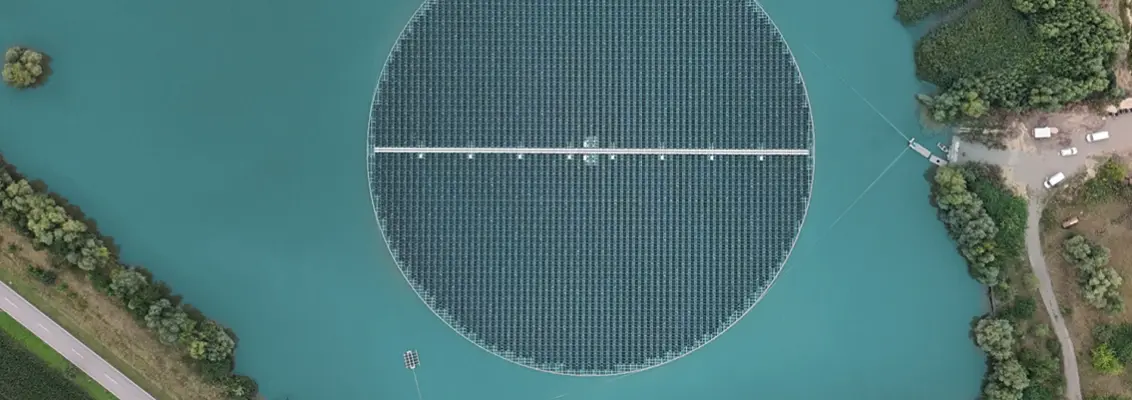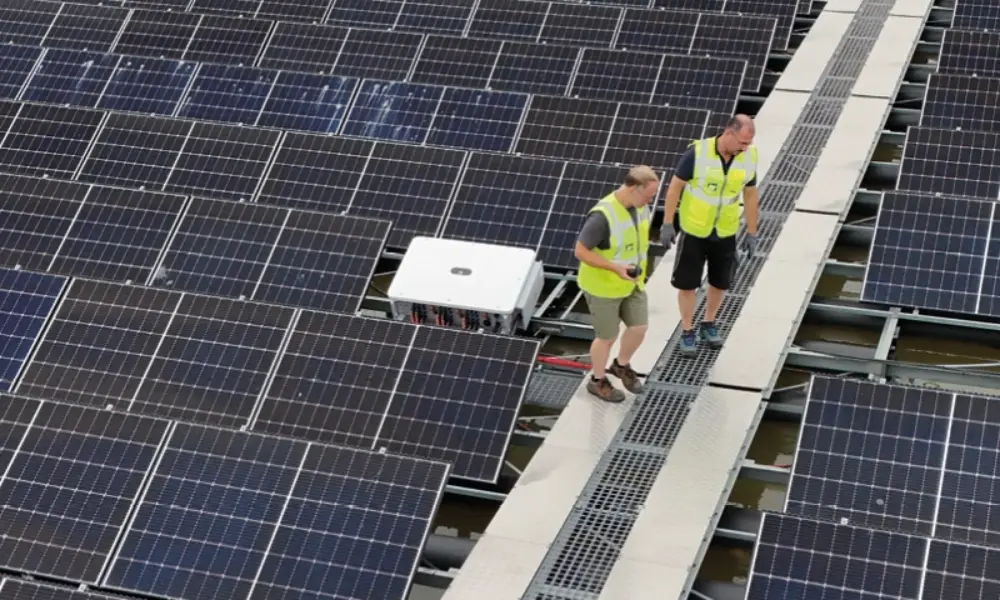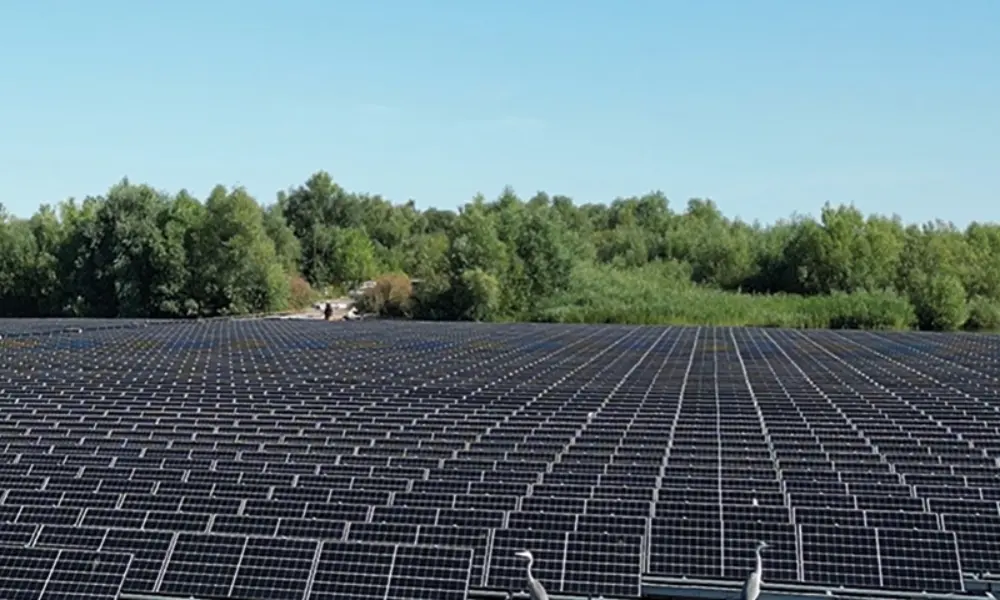Solar Cables for Floating Farms
Specialists in the construction, operation, and financing of photovoltaic systems, JM ProjektInvest lends their expertise to the construction of floating farms – solar farms installed on bodies of water. Many plants, such as a gravel plant in the eastern German state of Saxony-Anhalt, rely on this increasingly more popular source of green electricity to power their machines and conveyor belts.

“Floating photovoltaic systems, or floating farms, are the new trend,” says Stefan R. Müller, Director of JM ProjektInvest GmbH & Co. KG in Magdeburg, Germany. The company develops, constructs, and finances projects having to do with energy efficiency. Together with their customers, JM has become a holistic service provider for the optimisation and generation of energy.
Floating farms are still a relatively new domain. In contrast to traditional photovoltaics (PV), the solar modules of floating farms are mounted on floating platforms, which are usually anchored to the shore. This allows the modules to withstand the natural movements of the water. “Floating solar systems have several advantages,” says Director Müller. “The reflection of the sunlight off of the water is precisely what increases the efficiency of the solar modules.” The resulting evaporation of water helps cool the floating modules, and rope winches are used to turn the photovoltaic system, allowing it to follow the path of the sun. In this way, these floating modules achieve a higher yield – roughly 30 percent more compared to rooftop systems – while simultaneously taking up less space.
JM completed their first floating project together with the Neumann Gruppe, who operates a gravel quarry alongside Schimmel Kies- und Sandgewinnung GmbH in the municipality of Hoym in the state of Saxony-Anhalt. Quarry ponds from gravel pits are perfect for installing large-scale solar systems on floating platforms. The plant produces green energy that powers excavators, vibrators, and conveyor belts via their proprietary, sun-tracking photovoltaic island, which has an impressive diameter of 120 metres. Any excess electricity that is produced is fed into the public network.
The Connections that Matter
Integral to the operation of these systems are the cables and wires. They connect, for instance, the floating farm's individual solar modules to one another, to the power inverter, and the farm to the transformer station on shore. For these critical components, JM relies on solutions from HELUKABEL. The leading supplier of electrical connection technology has been a qualified supplier for JM since 2017. Starting with systems for small rooftops, their projects have continuously increased in scale. “We are not only able to provide them with quality cables, but also quality service,” says Roland Eggers, Regional Sales Manager at HELUKABEL.
The cables used in floating farms must be resilient against damage caused by moisture and sunlight. “Solar cables have a relatively simple construction. However, in practice, they need to fulfil many challenging requirements,” explains Eggers. They should be able to reliably transmit the power generated by photovoltaic systems for 20 to 30 years. This is why it is important that the cables used are of the highest quality and have been tested according to all current standards and regulations.
For photovoltaic systems, the safety and durability of the cables and accessories used, for example, to quickly and safely connect the individual solar modules together, are of the highest importance. The HELUKABEL MC4-EVO2 solar plugs are weather tight and exhibit low contact resistance and may also be used to connect the modules with the power inverter.
HELUKABEL expanded its portfolio specifically for floating farms to include the HELUPOWER SOLARFLEX-X H1Z2Z2-K Premium range. This model is certified according to TÜV 2 PfG 2750 and is therefore suitable for use in floating photovoltaic systems. “Currently, only a few manufacturers in Germany can offer cables with approvals for floating applications,” says Michael Thomczyk, Key Account Manager Photovoltaics at HELUKABEL. This range is resistant to weathering, UV radiation, ozone, and extreme temperatures, as well as is flame resistant and halogen free. Also, the approval according to DIN EN 50618 and IEC 62930 assures that the cables fulfil all technical requirements necessary to connect solar modules with power inverters. “We have also supplied them with different robust and resistant underground and medium-voltage cables, which connect the system with the existing infrastructure. This also includes waterproof control cables, as well as fibre optic data cables, which allow for the fast and reliable transmission of data at high bandwidths.”
The Full Package
“For projects like this, we are able to not only supply all of the required parts, but also provide comprehensive service,” promises Michael Thomczyk. HELUKABEL supplies JM with roughly 20 kilometres of material. "Not only are we happy with the technology supplied by HELUKABEL, but also with the collaboration," summarises JM Director Stefan R. Müller. "The instant we encountered a challenge, Roland Eggers was by our side, which is a level of service that you just don't expect. We can trust that the solution we need will be delivered in one or two business days at the latest. With HELUKABEL, you can expect not only extraordinary prices, but also exceptional reliability and quality."
ABOUT JM PROJEKTINVEST
JM ProjektInvest GmbH & Co. KG has specialised in the development, construction, operation, and financing of energy efficiency projects since their founding in 2010. The focus of the company was originally on the planning and construction of photovoltaic systems, but they have since developed into a provider of holistic services in the areas of energy efficiency and generation.
Learn more at jm-projektinvest.com
You can also find this and many other exciting articles in the current issue #16 of our customer magazine POWER. Read it now!


